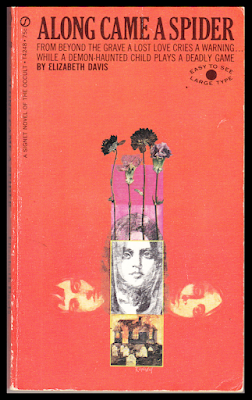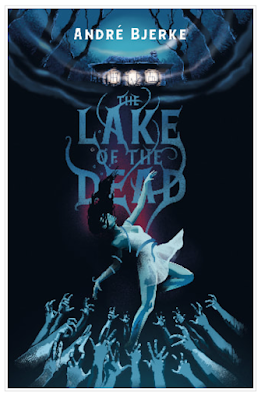THE STORY: The relatives of explorer and trader in African artifacts Nathan Claymole are summoned by invitation to visit him at his remote home isolated on a island surrounded by a torrential stream called the Boa. Some will be meeting him for the first time in their lives. In the letters of invitation Nathan has promised that each person will "learn something to your advantage." Little do they know what the night has in store for them. A weird ritual is about to take place on this night of the full moon, the dead will rise, and the family will fear for their lives as they
Pray for the Dawn (1946).
THE CHARACTERS: The novel is narrated by ballet dancer, and sometime actor Barry Vane, nephew to Nathan Claymole. Barry is down on his luck due to a disabling injury that has ended his career as a dancer and performer. Lack of work has resulted in dire financial straits for Barry. He is hoping that this "something to his advantage" promised in the invitation will be a boost to his impoverished bank account. There are seven other relatives who are also eager to find out why they were invited and what news Nathan has for them.
Caroline Claymole - Nathan's sister. A religious zealot and termagant extraordinaire who spends much of her time harassing and belittling her daughter...
Betsy - mousy bespectacled teenager browbeaten into submission by her tyrant of a mother. She seems to have no personality at all, or has had it eradicated by her overprotective mother's domination. But Betsy has a shocking secret that will change how she is viewed by everyone later in the novel.
Uncle Oscar - Caroline's wimpy cousin who spends much of the book silent and hiding in the shadows. But he also has a secret and a hidden aspect to his seemingly Casper Milquetoast persona
Jonah Clay - the oldest of the guests, Nathan's uncle and Barry's great uncle. Ancient and barely able to walk he is described by Barry as "Death outliving the grave." Nearly forgotten by the group he snoozes and mumbles in a corner until it's time to escort him upstairs to his room
Sylvia Claymole - the ingenue of the piece is lovely to look at, generous and kind to Betsy. Drawn to Barry's gentleman’s nature she will soon fall to pieces and become the most paranoid and fearful of the group.
Bret Janson - the American cousin and requisite dashing yet arrogant man that always shows up in these stories of gathered relatives. He spends a good portion of the book drinking heavily to fend off his fears
Tobias Judd - husband to one of Nathan's nieces who has apparently died unknown to the host. Judd has come in her place eager to learn what was promised to his wife. He is the most suspicious of the group and Nathan is wary of ulterior motives. Judd will turn out to be the most human, the one with the most common sense and, as the most level headed and courageous, ultimately he is the detective hero.
Nathan is assisted in his large lonely house by an African servant named Kish. This is perhaps the one aspect of the book that will prevent it from ever being reprinted. Kish's presence allows Harding to go to unnecessary lengths in talking about "jungle primitives" and the ominous nature of exotic foreigners. The book is littered with paragraphs contrasting civilized British life with the dark impulses of the jungle, the savage nature of Africans. What little interior decoration can be found in Nathan's home consists of African and South African artifacts. Strange masks and weapons decorate the walls and --most bizarrely -- shrunken heads also pop up in the decor scheme. Kish is not just a servant but also the personification of the Voice of Doom constantly uttering ominous statements in his pidgin English like "Dead sometimes come to life" and "Have care Boss. Strange ground."
And of course there is N'olah, the dwarf witch doctor whose corpse has been kept in an alcove room underneath a staircase. Nathan and Kish have kept a vigil all night, the 10th anniversary of the death of the South American shaman of the lost tribe of the Javiros who live in the Amazon jungles. [Yes, there was a corpse kept in the house for an entire decade.] Nathan expects that the witch doctor will be resurrected after some odd ritual magic and African mumbo jumbo. His guests are quite rightly disturbed and frightened.
When the body vanishes due to a mix-up in the changing of the guard, so to speak, between Nathan and Kish the guests’ reactions range from unsettled to outright terror. Many of them actually believe that the corpse has come to life. After hearing the strange story Nathan has told about why he and Kish brought the body back from South America the relatives are convinced the zombie is out for revenge. A search is arranged with Toby leading one group and Nathan leading another. They two groups head off to find out if the corpse has come to life or if it was ever a corpse to begin with. Eerie events, fights, scuffles, and attacks occur for the next several hours. Nathan orders that the bridge crossing the violently coursing stream be destroyed which will prevent N'olah from leaving but also prevents all the guests from escaping the island. When Jonah is found strangled in his bedroom the novel begins to seem more and more like And Then There Were None redux with a zombie on the loose as the killer. At this point horror and hysteria are unleashed at full throttle.
ATMOSPHERE: Speaking of hysteria unleashed... Most striking to me is the manner in which Harding sustains the dread, fear and paranoia. It infects the entire group like a horrible virus. Oscar, the wimp, is seen growling and snarling at Barry. Sylvia loses control and keeps ranting about their collective demise: "Eight nooses! Eight guests! We're all going to be murdered!" But it is Caroline's transformation from spinsterish finger-wagging Bible thumper to full-blown religious maniac that serves as the climax of the book.
In one of the longest and creepiest sections of the novel Barry, Sylvia and Toby pursue Caroline into the labyrinthine cellars of Nathan's ancient home. There Caroline finds Kish in front of a firelit altar performing an outlandish ritual complete with African chanting, and ecstatic dancing. She and Kish have a battle and she ends up destroying a wooden idol he was directing his chanting toward. Caroline has made both a literal and figurative descent into madness all because her daughter has gone missing. She fears the worst and no one can find Betsy. In the midst of her insane fight and destruction of the idol she reveals the deep dark secret that is at the core of Betsy's lack of personality. It's a shocker of a confession and gave me a thought. I suddenly realized that there was a parallel to this book and Stephen King!
Caroline --who is called Carrie by her relatives -- is a religious zealot overly protective of her mousy personality-less daughter who everyone else sees as a freak. Ring any bells? This coincidence just blew my mind. Caroline, her relationship with Betsy, the heavy-handed quoting of Biblical passages and general over-the-top religious kookiness uncannily foreshadow Margaret White and her relationship with her own freak daughter in King's debut novel Carrie written three decades later. Both Carrie White and Betsy Claymole have a secret connected to violence. While Betsy is not a telekinetic monster when enraged she is just as murderously dangerous. Perhaps it's a wildly imaginative stretch to think that King might have come across Pray for the Dawn in his youth, but he has been known to borrow from everywhere, horror comic books to old TV movies, for his plots. Of course it might all be coincidence but it's a mighty crazy coincidence, if you ask me.

INNOVATIONS: Harding includes an "Author's Note" (see the photo at right) at the start of the book stating that
Pray for the Dawn is not a detective novel. He goes into detail to justify why the book is structured the way it is and why it shouldn't be considered a "fair play" detective novel, but rather an adventurous thriller. But that disclaimer, of sorts, is a huge red herring. The book is indeed a detective novel, albeit a very unconventional one. Scattered throughout the story are multidinous red herrings all of which I fell for alongside several cleverly planted clues that can lead you to figuring out exactly what is going on, who the murderer is, and why Jonah and one other person were strangled.
It is not unfair of me to reveal that all of the supernatural events will turn out to be rationalized. For all the hysteria and horror encountered within the pages of this genuinely terrifying and thrilling book there is no black magic at work, no ghosts, no zombies. But it is rather obvious at the midpoint of the book as Toby Judd reminds Barry and Sylvia that the spooky events are all being engineered by some madman. But exactly who is it? What happened to the dwarf witch doctor's corpse? Why are the nooses being used to strangle the victims? And what is the purpose of the secret dossier on all the guests which reveals the details of their lives including all their secrets?
THE AUTHOR: Eric Harding is perhaps a pseudonym for a writer that no one knows very much about. He is the author of only two crime novels
Pray for the Dawn (1946) and
Behold! the Executioner! (1939), both titles so scarce that they are nearly impossible to find anywhere. I found only one person of note who used Eric Harding as a pseudonym but he turned out to be Eric Harding Thiman (1900 - 1975) organist, composer of songs and church music and Professor of Harmony at Royal Academy of Music. Thiman's
biographical information is rich with his accomplishments as a musician, composer and academic and I learned that he wrote a few songs early in his career using the name Eric Harding. Is he also responsible for these two bizarre crime novels in that guise? Anyone who knows anything about either man, please feel free to enlighten us all in the comments.

































